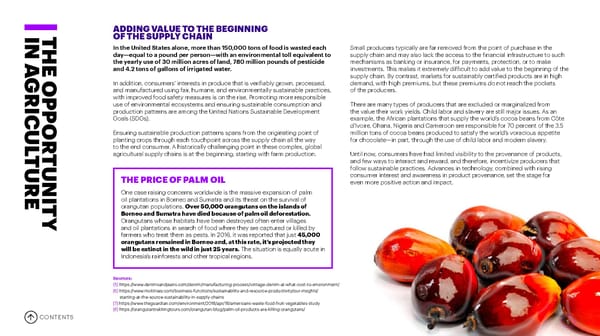ADDING VALUE TO THE BEGINNING IN A THE OPP OF THE SUPPLY CHAIN Small producers typically are far removed from the point of purchase in the In the United States alone, more than 150,000 tons of food is wasted each day—equal to a pound per person—with an environmental toll equivalent to supply chain and may also lack the access to the financial infrastructure to such the yearly use of 30 million acres of land, 780 million pounds of pesticide mechanisms as banking or insurance, for payments, protection, or to make and 4.2 tons of gallons of irrigated water. investments. This makes it extremely difficult to add value to the beginning of the GRICUL supply chain. By contrast, markets for sustainably certified products are in high In addition, consumers’ interests in produce that is verifiably grown, processed, demand, with high premiums, but these premiums do not reach the pockets and manufactured using fair, humane, and environmentally sustainable practices, of the producers. with improved food safety measures is on the rise. Promoting more responsible use of environmental ecosystems and ensuring sustainable consumption and There are many types of producers that are excluded or marginalized from production patterns are among the United Nations Sustainable Development the value their work yields. Child labor and slavery are still major issues. As an OR Goals (SDGs). example, the African plantations that supply the world’s cocoa beans from Côte d’Ivoire, Ghana, Nigeria and Cameroon are responsible for 70 percent of the 3.5 Ensuring sustainable production patterns spans from the originating point of million tons of cocoa beans produced to satisfy the world’s voracious appetite planting crops through each touchpoint across the supply chain all the way for chocolate—in part, through the use of child labor and modern slavery. to the end consumer. A historically challenging point in these complex, global TURE TUNIT agricultural supply chains is at the beginning, starting with farm production. Until now, consumers have had limited visibility to the provenance of products, and few ways to interact and reward, and therefore, incentivize producers that follow sustainable practices. Advances in technology, combined with rising THE PRICE OF PALM OIL consumer interest and awareness in product provenance, set the stage for even more positive action and impact. One case raising concerns worldwide is the massive expansion of palm oil plantations in Borneo and Sumatra and its threat on the survival of orangutan populations. Over 50,000 orangutans on the islands of Y Borneo and Sumatra have died because of palm oil deforestation. Orangutans whose habitats have been destroyed often enter villages and oil plantations in search of food where they are captured or killed by farmers who treat them as pests. In 2016, it was reported that just 45,000 orangutans remained in Borneo and, at this rate, it’s projected they will be extinct in the wild in just 25 years. The situation is equally acute in Indonesia’s rainforests and other tropical regions. Sources: (5) https://www.denimsandjeans.com/denim/manufacturing-process/vintage-denim-at-what-cost-to-environment/ (6) https://www.mckinsey.com/business-functions/sustainability-and-resource-productivity/our-insights/ starting-at-the-source-sustainability-in-supply-chains (7) https://www.theguardian.com/environment/2018/apr/18/americans-waste-food-fruit-vegetables-study (8) https://orangutantrekkingtours.com/orangutan-blog/palm-oil-products-are-killing-orangutans/ CONTENTS 55
 Imagine... A New Generation of Fairer Trade Now Page 4 Page 6
Imagine... A New Generation of Fairer Trade Now Page 4 Page 6